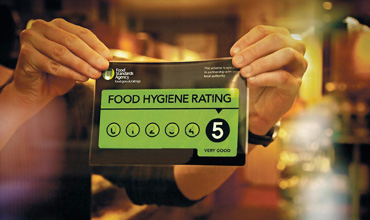An Assessment of Attitudes towards and Practices of Food Hygiene among Babcock University Cafeteria Workers

Abstract:
This
descriptive cross-sectional study assessed various hygiene practices among 250
Babcock University cafeteria workers, and the hygienic condition of the working
environment. Most of the respondents, 126 (50.4%) were ever married, females
146 (58.4%), Christians 208 (83.2%) and of the Yoruba ethnic group, 128
(51.2%). Result findings revealed that 226(90.4%) respondents had good
knowledge of food hygiene, and 206(82.4%) knew that protective wears reduce the
risk of food contamination and accidents in the cafeteria. However, 167(66.8%)
of the respondents were not aware that virus causes food contamination. Only 83(33.2%)
of the respondents indicated that they clean their working environment two
times a day while 41(16.4%) of the respondents clean once a day meaning
majority of the respondents, 126 (51.4%) do not clean regularly resulting in a
questionable working environment. Findings also show that only 60 (24%)
respondents use personal protective equipment (PPE) any time they are in the
cafeteria while 104 (41.6%) make use of PPE when preparing and serving food. Bi-variate
(Chi-square test statistics) analysis revealed significant relationships
between attitude and age (p= 0.05); hygiene level of working environment and
tribe (p=0.008); level of hygiene practices versus marital status (p=0.035) and
tribe (p=0.001); level of use of PPE versus marital status (p=0.006) and
knowledge of respondents (p=0.001). The study concluded that though workers in
Babcock University cafeteria have satisfactory level of knowledge and good
attitude towards food hygiene practices, their level of environmental hygiene
practices are not adequate. Recommendations include training programs to
re-orientate the workers on proper environmental hygiene practices and daily
work environment inspections.
References:
[1.] Abhay, B.M. (2010). Health Status and Personal
Hygiene among Food Handlers Working at Food Establishment around a Rural
Teaching Hospital in Wardha District of Maharashtra, India. Global Journal of Health Science; 2(2): 190-206
[2.] Aimee, S., Pragle, M.S., Anna, K., James, C.
(2007). Food Workers’ Perspectives on
Handwashing Behaviors and Barriers in the Restaurant Environment. Journal of Environmental Health Volume; 69(10):
27-32
[3.] Angelillo, F., Viggiani, N.
M. A., Greco, R. M., & Rito, D. (2001). HACCP and food hygiene in
hospital: knowledge, attitudes, and practices of food-services staff in Calabria,
Italy. Infection Control and Hospital
Epidemiology, 22(6):1-7
[4.] Barro, N.,
Bello, A.R., Itsiembou, Y., Savadogo, A., Ouattara, C.A., Nikiema, A.P (2007). Street-Vended Foods Improvement: Contamination Mechanisms and Application
of Food Safety Objective Strategy: Critical Review. Pakistan
Journal of Nutrition; 6 (1): 1-10.
[5.] Ehizibolo, D.O., Chukwu, C.O., Chukwu, I.D.,
Muhammad, M.J., and Olabode, A.O. (2007). Occurrence of Food borne Bacteria
Pathogen in Smoked fish at Retail Level in Jos, Nigeria. Nigerian Veterinary
Journal; 28(1):21-26.
[6.] Gashaw I, Stiller S, Boing C,
Kimmig R, Winterhager E. Premenstrual regulation of the pro-angiogenic factor
CYR61 in human endometrium. Endocrinology. 2008:149:2261-2269
[7.] Green, L.R., C.A. Selman, V.
Radke, D. Ripley, J.C. Mack, D.W. Reimann, T. Stigger, M. Mostinger, and L.
Bushnell. 2006. Food worker hand washing practices: an EHS-Net observation
study. Journal of Food Protection.
69(10):2417-23
[8.] Ifenkwe, G.E. (2012). Food safety regulations: reducing the risk of food-borne diseases in
rural communities of Abia state, Nigeria. Agricultural Science Research Journals; 2(7): 384-389.
[9.] Maizun, M.Z., Nyi, N.N. (2002). Sociodemographic
Characteristics of Food Handlers and Their Knowledge, Attitude and Practice
towards Food Sanitation: A Preliminary Report. Southeast Asian J Trop Med Public Health; 33(2):410-417
[10.] Mulugeta,
K and Bayeh, A. (2012). The Sanitary Conditions of Food Service Establishments
and Food Safety Knowledge and Practices of Food Handlers in Bahir Dar Town. Ethiopian Journal of Health Science; 22(1): 27–35.
[11.] Murat, B., Azmi, S.E., Gokhan, K. (2006). The Evaluation
of Food Hygiene Knowledge, Attitude and Practices of Food Handlers in Food
Businesses in Turkey. Journal of food
control; 17: 317-322.
[12.] Nevin, S.,
Faith, T. (2010). Perceptions of Hygiene among Staff Working in Food
Companies. Research Journal of Medical Sciences;4(3):231-237.
[13.] Oranusi,
S., Galadima, M., Umoh, V.J. and Nwanze, P.I. (2007). Food safety evaluation in
boarding schools in Zaria, Nigeria, using the HACCP system Scientific Research and Essay; 2(10): 426-433.
[14.] Orefi, A. (2012) Food Security in Nigeria and South Africa:
Policies and Challenges. J Hum Ecol,
38(1): 31-35.
[15.] Siow, O., Norrakiah, A.S. (2011). Assessment of
Knowledge, Attitudes and Practices (KAP) Among Food Handlers at Residential
Colleges and Canteen Regarding Food Safety. Sains
Malaysian; 40(4):403–410.
[16.] William, G.K., Bekker, J.L. and Onyango, R.O.
(2012). An Assessment of
Knowledge, Attitudes and Practices of Food Handlers in Food Kiosks In Relation
To Food Hygiene in Eldoret, Kenya. International
Journal of Current Research; 4(04):127-138.

